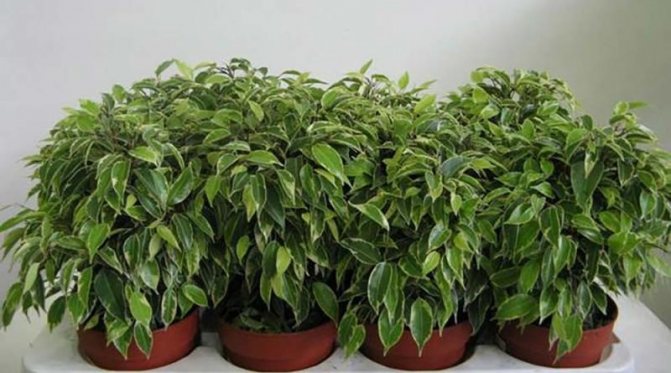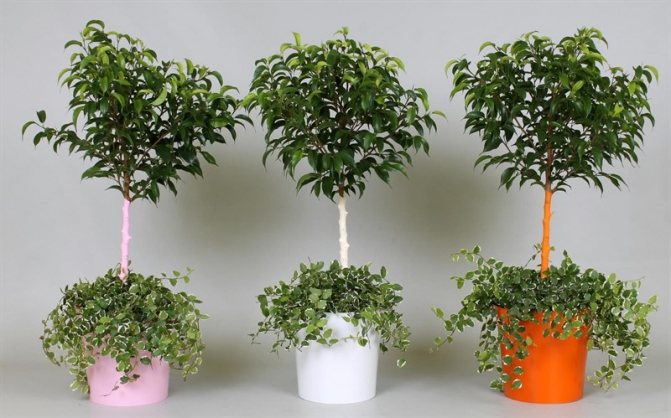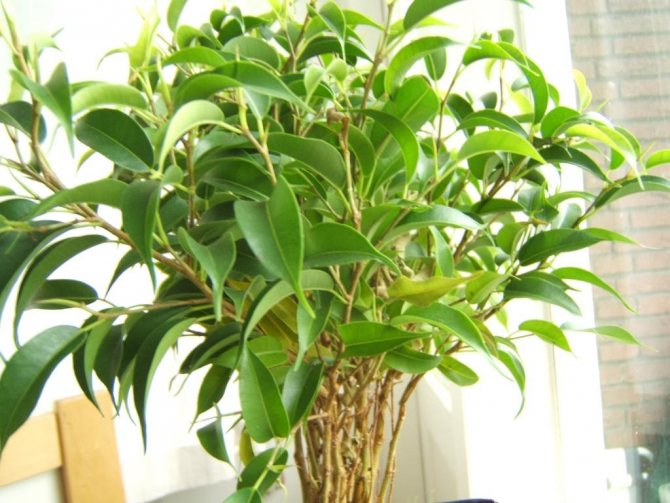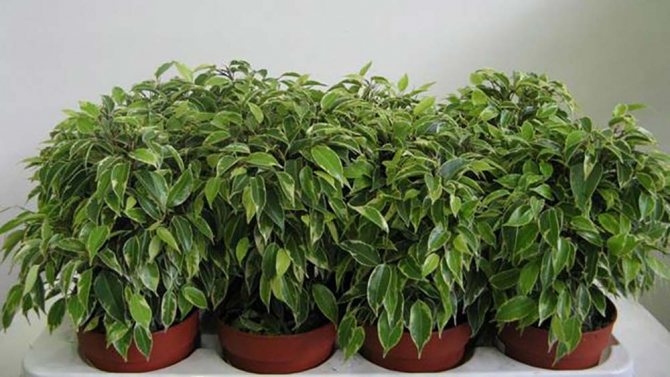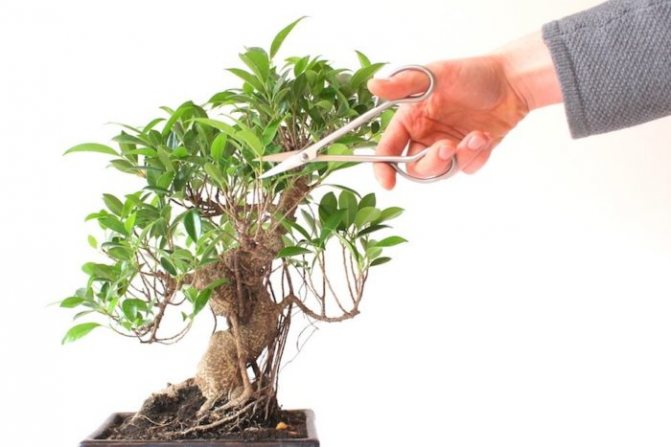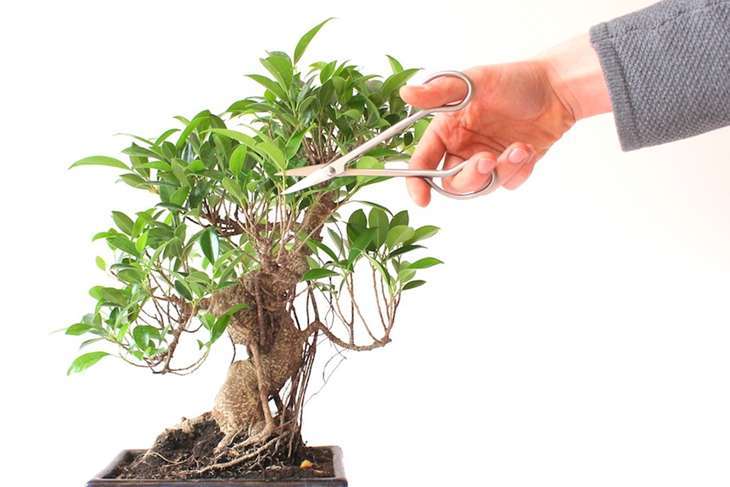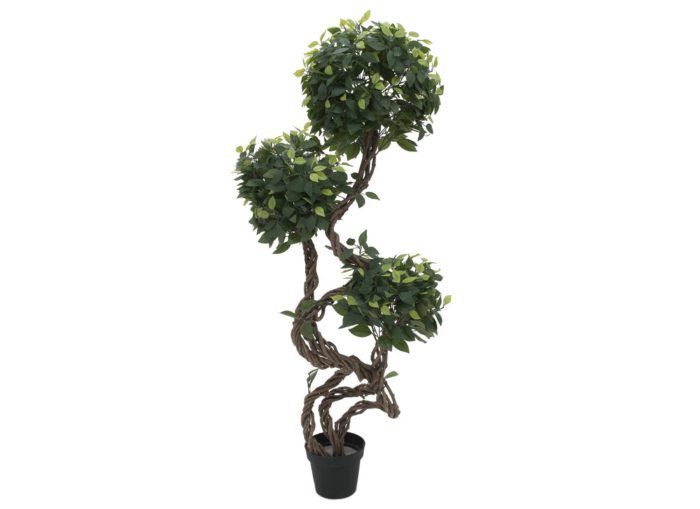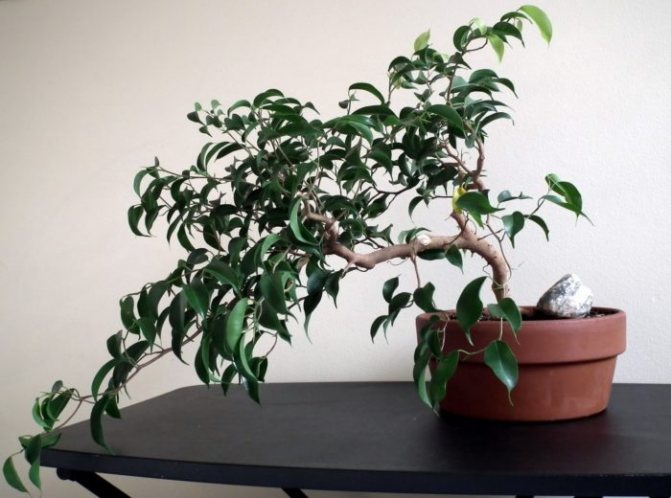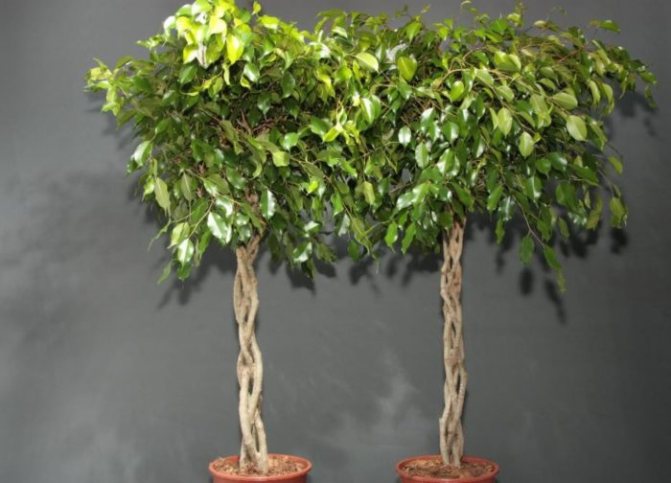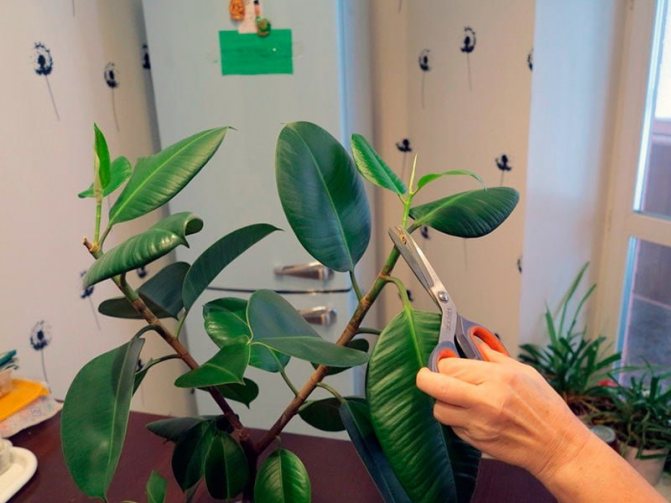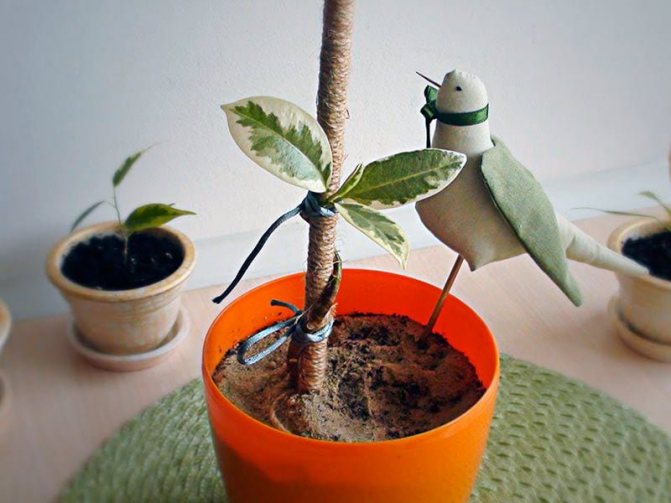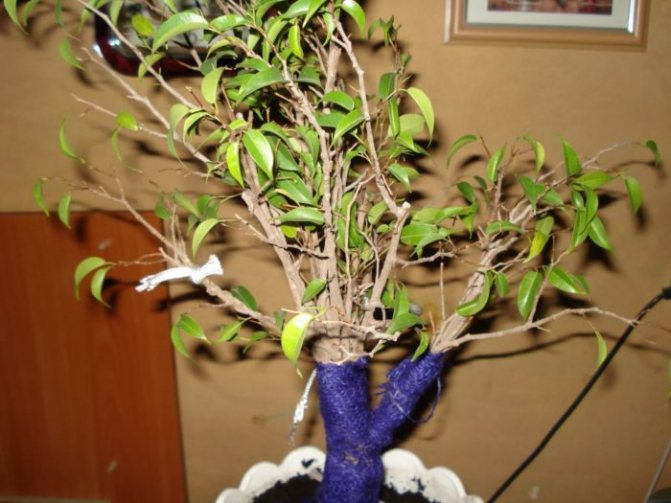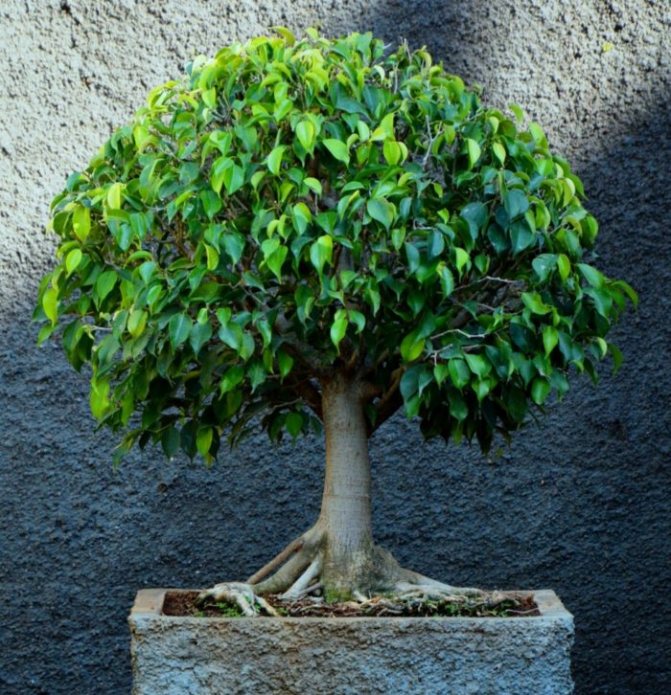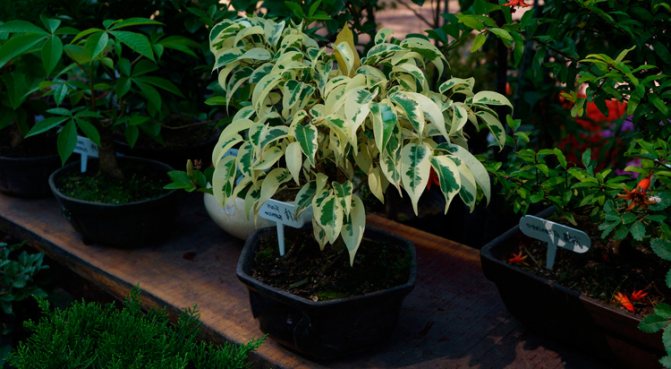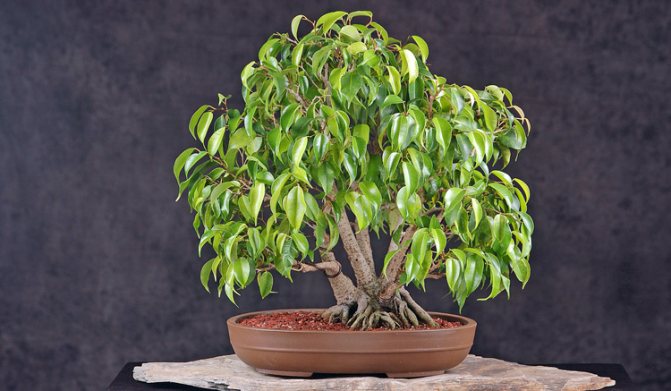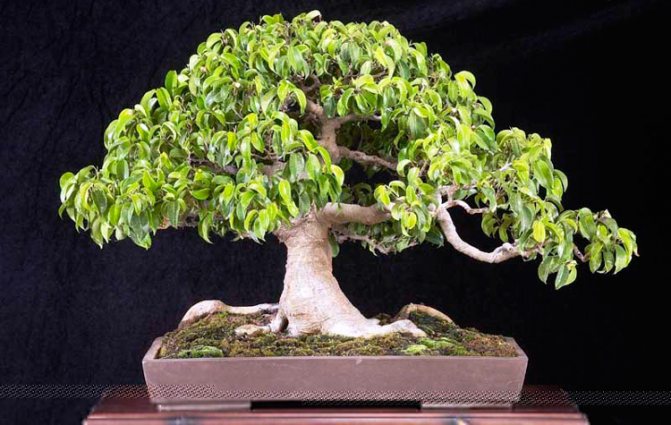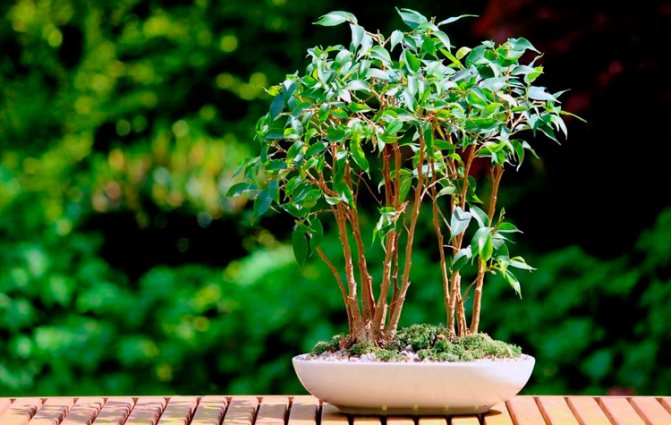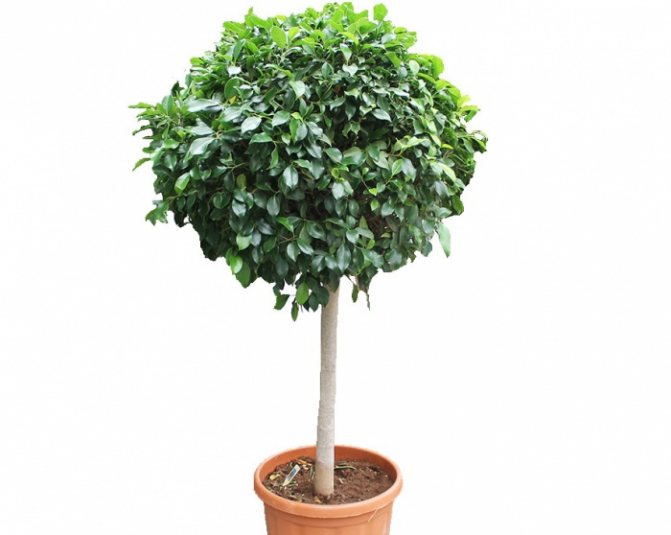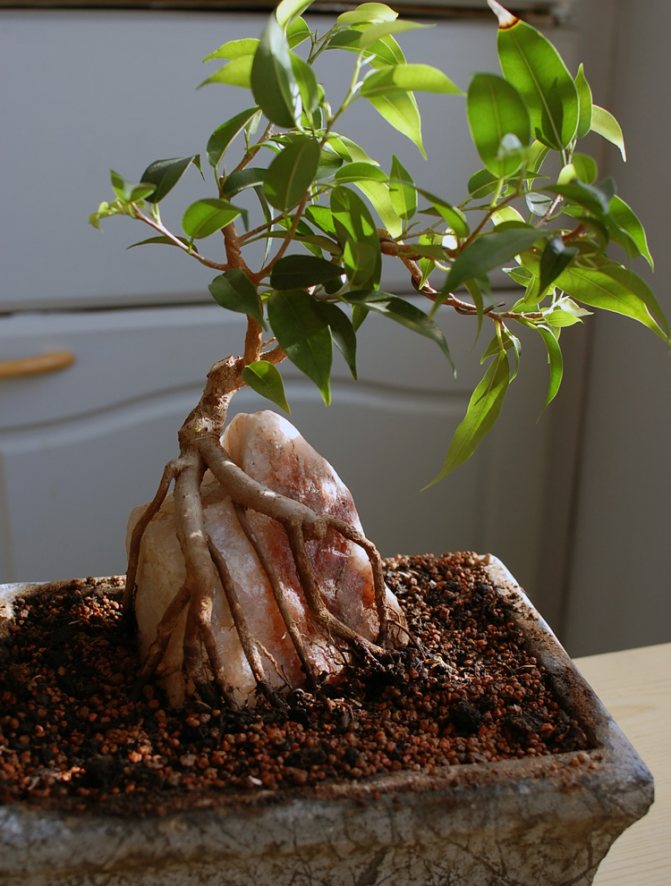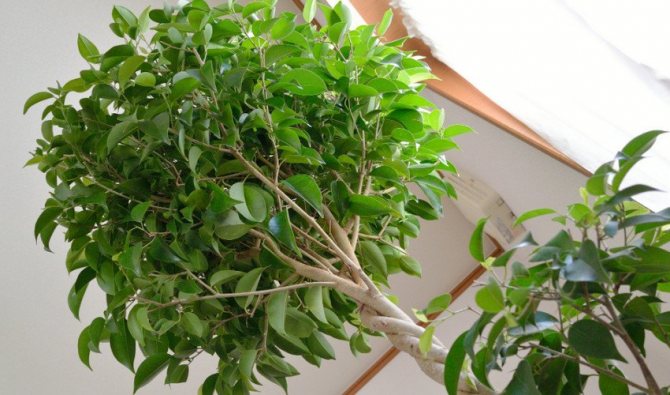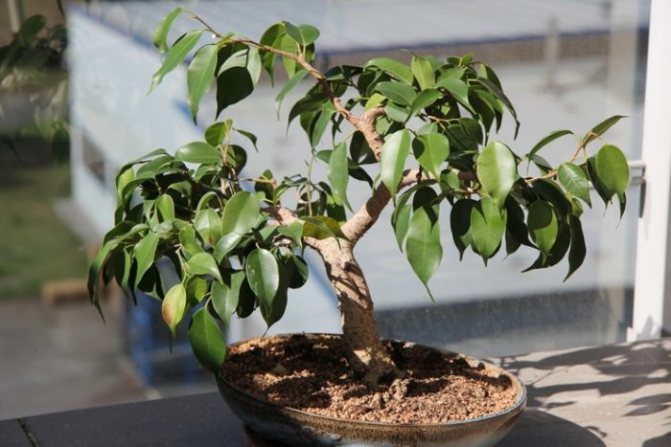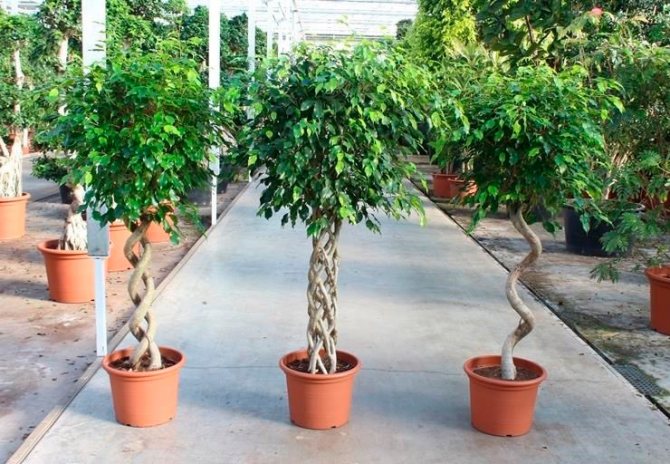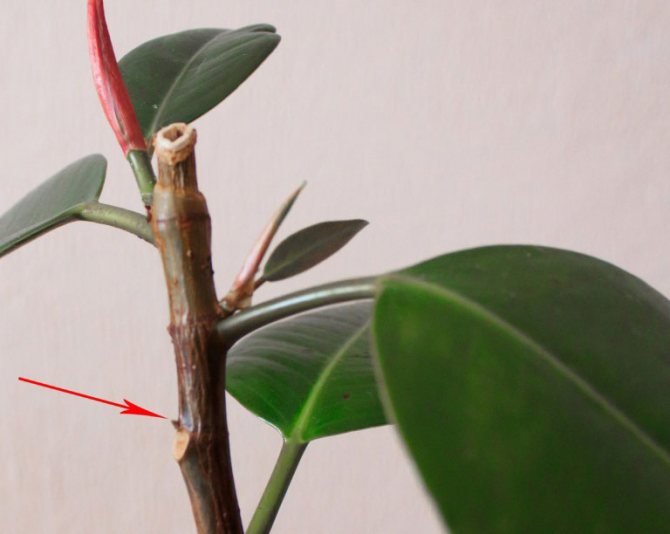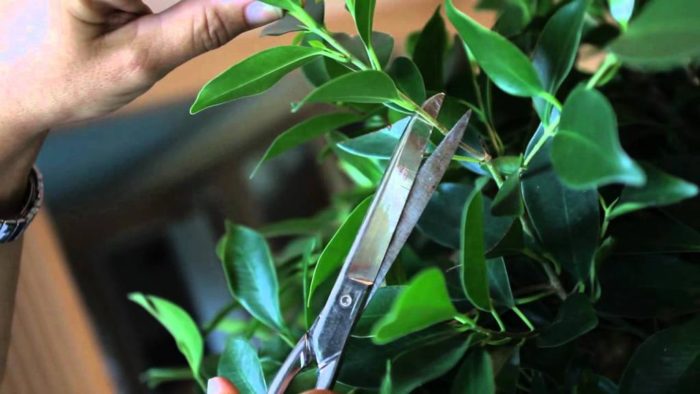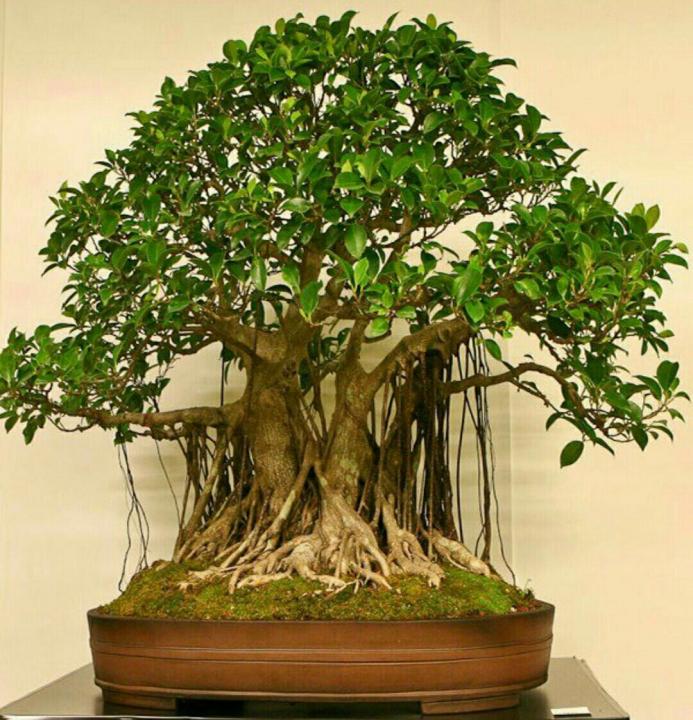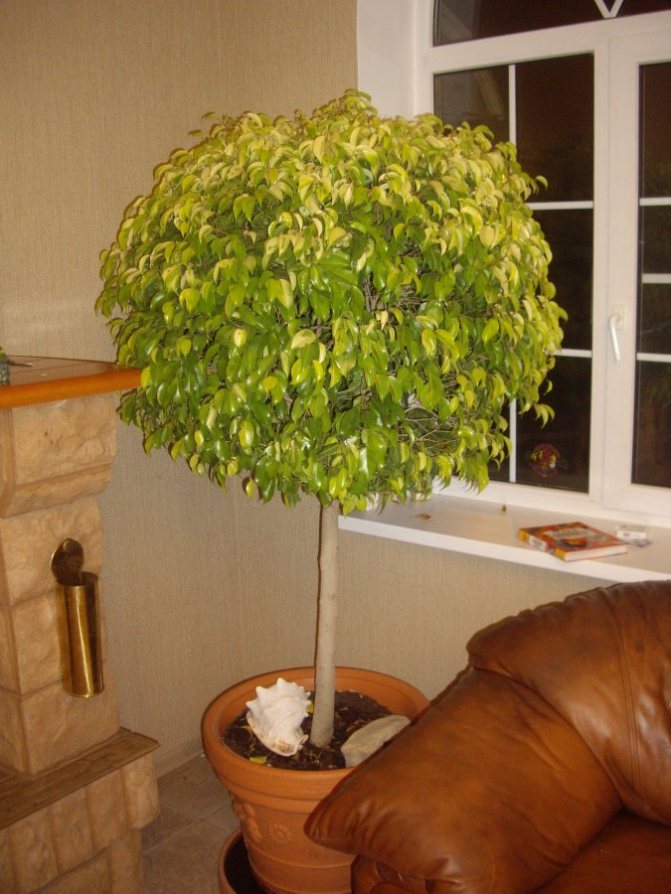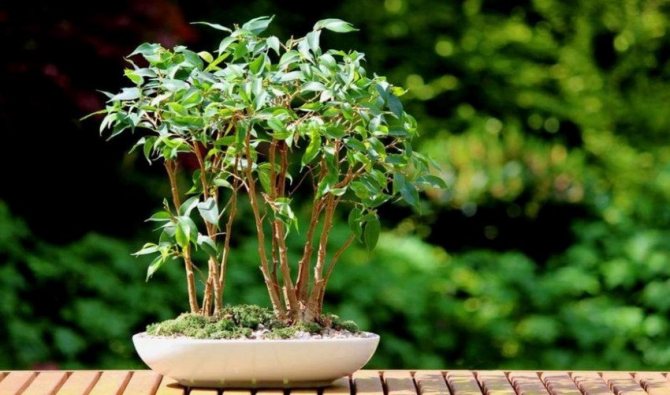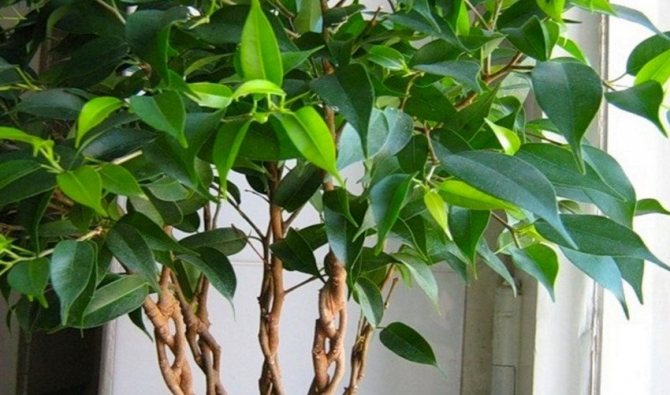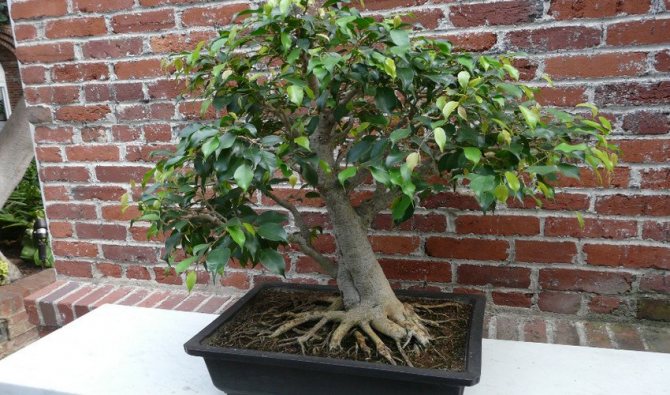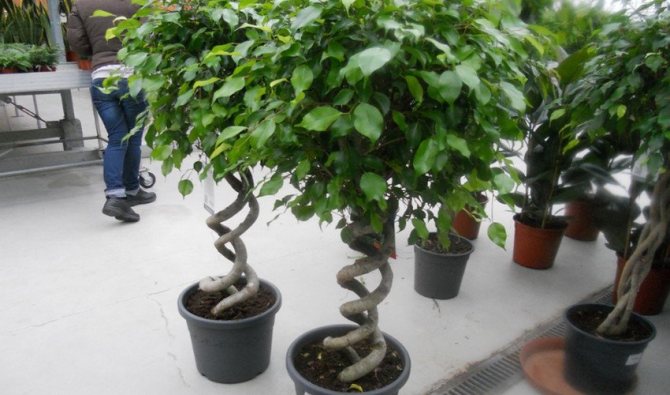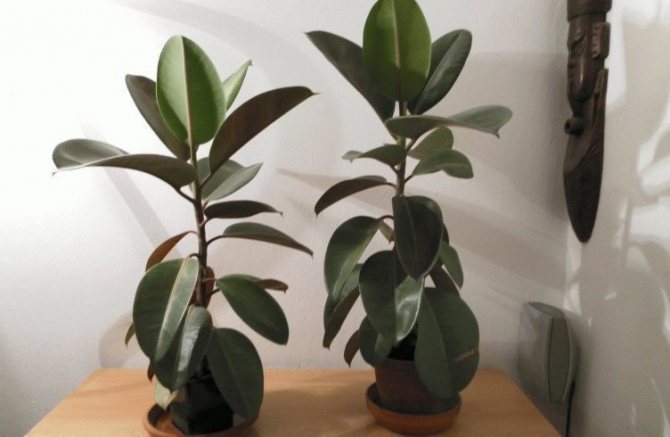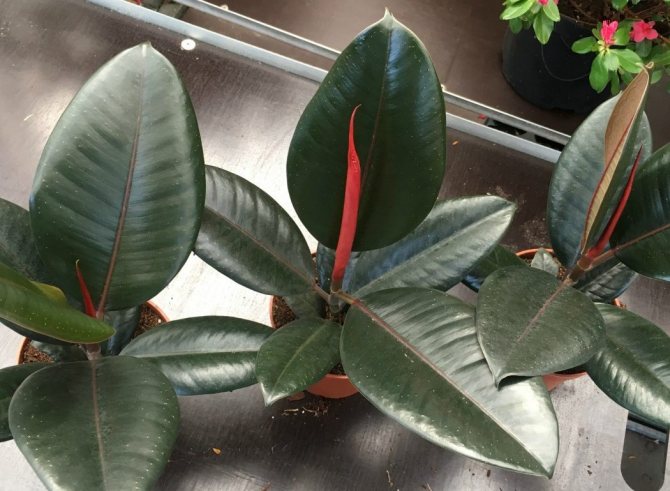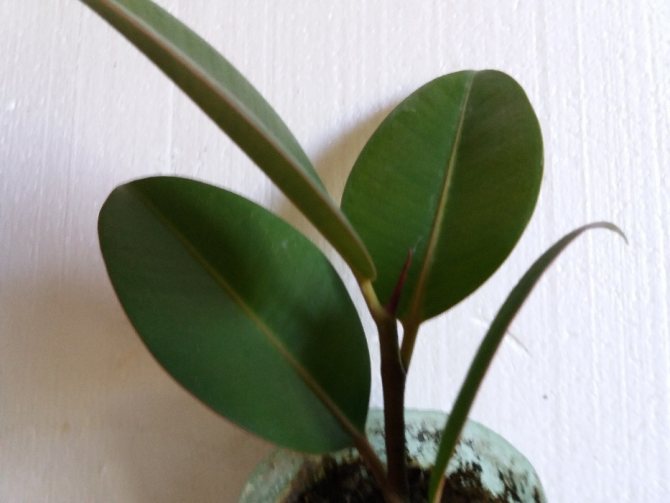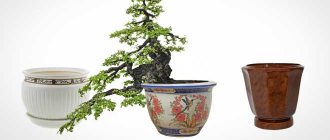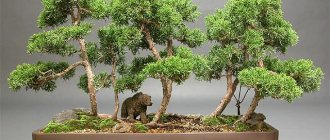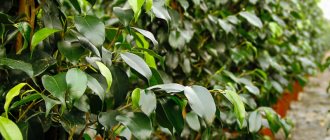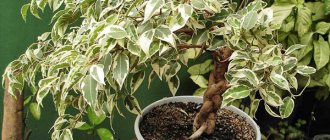Plants »Flowers
0
1344
Article rating
Ficus Benjamin is one of the most popular houseplants in our country. This is due to many factors: it does not require special care, is very attractive in appearance and has high decorative properties. The main thing that is required of the owners is to timely carry out the formation of the crown, then the flower will appear in all its glory.
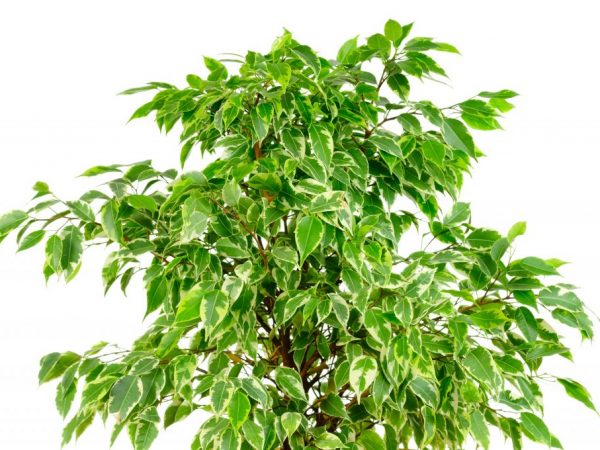
Ficus Benjamin crown formation
Photo
See a photo of what Benjamin's ficus looks like and how it grows at home.
Examples of photos of how trunks can be braided.
And a photo of how you can form a beautiful crown of a plant.
Varieties of the crown
Creating a ficus crown is a fairly simple procedure that anyone, even a novice florist, can do. This can be done in different ways.
Bushes
This shape is achieved through periodic pinching of the main branches, after which the development of lateral buds is activated. As soon as the side shoots reach 10 cm in length, they also need to be pinched. After a while, it will be possible to form a very dense, beautiful crown.
Sculptures
The sculpture of a bush looks best on plants with a small crown, which Benjamin belongs to. Correct regular pruning will allow you to make a crown of almost any shape: from the simplest geometric shapes to the outlines of people and animals.
Braids
It will not be easy to achieve the desired shape, but the appearance of the crown will exceed all expectations. You can beautifully braid the trunks with a pigtail and at the same time collect shoots with a net or a fence.
Boles
In order to form a crown in the form of a trunk, you should choose a stem of a young plant with a strong main shoot. Only 5 of the most beautiful upper branches are left on it, the rest of the processes are regularly cut off.
The procedure is carried out until each branch grows to the desired stem size. Then, without stopping trimming the side shoots, pinch the upper buds.
The crown of the trunk is of several varieties. Often, when asked how to form a ficus, they answer that a tiered stem is the best crown shape for a similar flower.
Necessary conditions for a plant
Lighting


You need to put a pot of ficus in a bright place. The plant likes indirect light, so it is better to place it at a distance of 1 meter from the south window. In winter, you need to supplement the plant, because if there is not enough light, it can shed its leaves.
Temperature


In summer, it should be between 18 and 23 degrees.
Also, you need to be aware that many variegated varieties are very fond of heat.
It is very important to pay attention to the ambient temperature.
Air humidity
It should be tall. You should spray the plant with water at room temperature, and after turning on the heating, it should be placed away from radiators.
How to water?
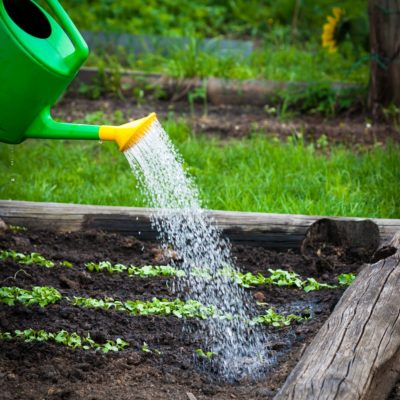

If we talk about watering, then there is no special schedule for how often it is necessary to do this and after how many days to water the plant. Watering may vary at different times of the year. You should carry it out so that the soil is not waterlogged.Watering is carried out in several stages, since it is very important to saturate the entire earthen lump. Excess water should be in the pan, after which it is drained.
What kind of land is needed?


The soil for such a plant needs a slightly acidic, fertile one.
Take some of the turf, some of the sand, and a small percentage of charcoal. Sand can also be replaced with peat. It is necessary to make drainage, so there should be expanded clay below, and sand above.
Dates of the procedure
Depending on the purpose for which the shrub is being cut, the timing of this procedure is set. In no case should they be violated, because this will harm the further growth and development of the plant.
The formation of the crown and trunk of a young ficus is carried out every spring, around mid-March. This procedure is necessary so that in the future the plant has the appearance that the gardener desires. To form, the shrub can undergo cardinal pruning (with the removal of more than 20 percent of the branches) or cosmetic (up to 5 percent of the shoots).
A haircut is best done in late October or early November. In winter, the plant goes into hibernation, during which it practically does not accumulate nutrients from the soil, and survives at the expense of the available reserves. The amount of vigor of the shrub during the cold season is strictly limited, so it is irrational to spend it on sick and weakened shoots.
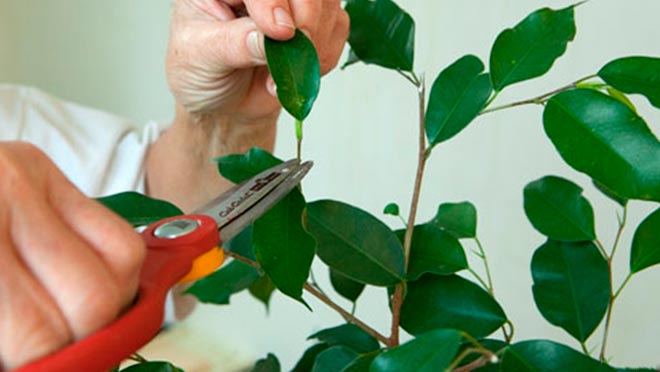

It is possible to trim the bush so that it grows beautifully throughout the spring and summer, if the changes in the structure of the crown are not dramatic. Making small trims and removing excess leaves will not stress the plant too much.
Possible problems
What if it doesn't grow?


There may be a lot of reasons why the plant does not grow and does not feel well. The foliage may fall off, turn yellow as a result of improper care of the indoor flower. To ensure the comfort of the plant, it is important that the lighting is bright, but diffuse.
If you compare it with other flowers, then the foliage of the ficus is small and thin. This means that the sun's rays can be the cause of the painful condition. They lead to moisture evaporation and dehydration, and when the plant is deprived of this, it stops growing.
Causes of slow growth
If you notice that your ficus grows very slowly, this may be due to the following reasons:
- Not enough light.
- Inconsistency of temperature conditions.
- Unsuitable air humidity.
- Frequent change of place.
Shaping the trunks
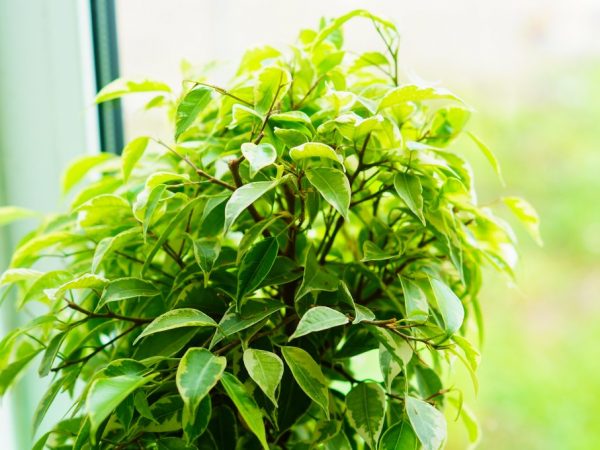

The flower can be given an interesting shape
To give the ficus trunk an original appearance, you first need to plant several identical plants in one pot at once, and then intertwine them in one of the possible ways. The trunks should not only be of the same species, but also of approximately the same age. The required shoot length is 16-20 cm.
A popular way to form the trunk of Benjamin's ficus is a scythe. For this, three young plants are planted nearby. As they grow up, they are woven according to the intended plan. For those who want to twist the ficuses with a spiral, 2 copies are enough.
Weaving the trunks, be sure to remove all young shoots from the sides. Do not weave very tightly and tightly: because of this, the thickening may be disturbed, and the trunks will begin to develop inharmoniously. At each stage of weaving, the result is fixed with a soft woolen thread. At the same time, they try to maintain an angle of 45 ° C and not crush the trunks.
Once every 2-3 months, the old fixing threads are replaced with new ones. It is advisable to additionally provide the trunk of each plant with a support.
How to plant?
Ficus Benjamin can be planted with seeds. They are often bought in specialty stores. Before planting, you need to prepare a soil consisting of humus, turf and sand. Bone meal can also be added to create the most comfortable conditions.No seed treatment is required.
As a rule, seeds are planted in the ground to a depth of 5 mm. The container is placed in a bright place, and in order to maintain a high level of humidity, it is placed in a plastic bag.
After the appearance of young shoots, a pick of plants is carried out.
We form a ficus in the form of a bush
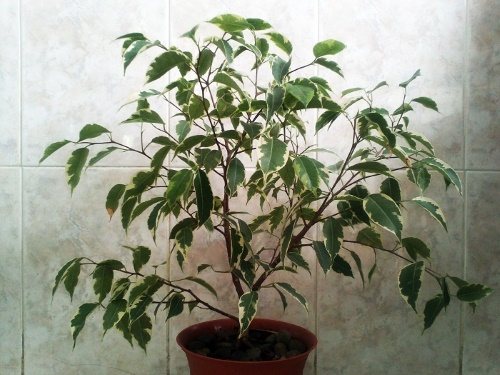

For indoor growing, a bushy crown shape is often used - it looks beautiful, and such a ficus will not take much space.
It is necessary to form a bush from the first year of life, and in the future, to constantly regulate growth. This is done in this way:
- When the stalk grows to 15 cm in height, cut off the top of the ficus. At least 5 leaves should remain on the remaining stem.
- Upon reaching the new, side, branches of the same length, they also need to be pinched.
- This is done with all the branches. In this case, the upper kidney, over which the cut is made, should look outward.
To make the bush more lush, you can plant several cuttings in one pot at once. Over time, if the crown is too thick, a couple of shoots are cut from the inside for thinning.
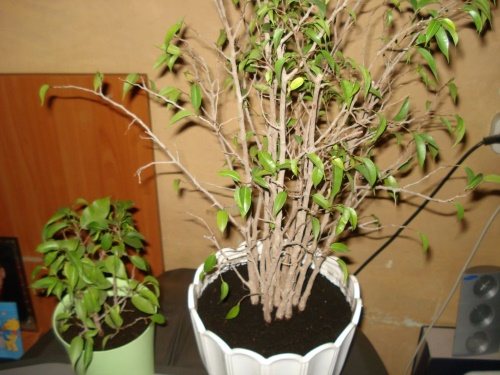

Periodically turning the ficus flowerpot towards the sun will ensure uniform growth of the branches.
When can you transplant?
The best time to transplant is spring. The ficus must be removed from the pot, and then the roots of the plant must be examined. If they are firm enough, the plant can be replanted. If there are unhealthy areas, then they need to be pruned, otherwise the plant will continue to die.
The earthen lump needs to be relieved. To do this, it is worth removing the top layer that has adhered to the base. After that, it will be possible to check how the roots of the plant fit into the new pot. Choose the pot that you like best, the main thing that you need is that there is enough space in it for the development of the root system, be sure to make sure of this when you plant the plant.
You can read more about Benjamin ficus transplantation here.
Ficus pruning rules
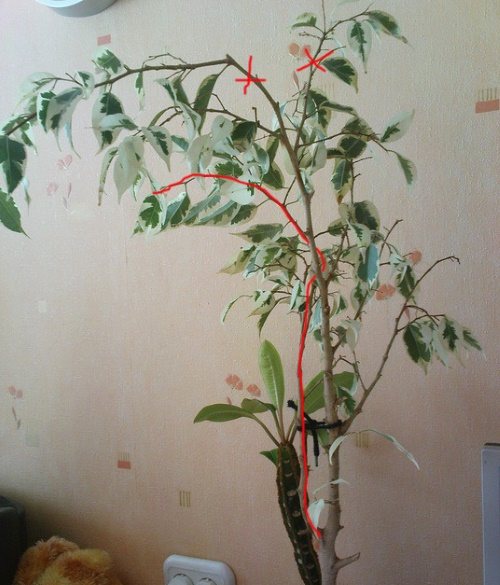

It is better to start the formation of ficus in early spring. This also applies to sanitary pruning - the removal of dry, diseased and incorrectly growing branches is carried out in the month of March. This is the time when growth processes are activated in all plants and active sap flow begins. In the autumn-winter period, pruning is not worth doing - the ficus will “think” for a long time before it grows.
Young branches must be cut directly above the bud, in a straight line. Old thickened shoots should be cut with a slanting cut closer to the bud.
After the completion of the haircut, all the places of the cuts should be blotted with a napkin, removing the juice, and sprinkled with crushed activated carbon. This is to prevent the development of infections.
How to root the shoots?
Shoot rooting can be done in several ways:
- Using a container with warm water. It covers only the nodes of the plant. It is also important to create high humidity, so it is a good option to cover it with a bag or jar.
- Lowering the cuttings into the substrate. Sand or peat can be used as a substrate. It should be sufficiently damp or warm. Immediately before planting a shoot in it, sprinkle the soil with a tablet of activated carbon. The substrate should be moist, but not damp.
- Rooting of aerial shoots. To do this, make 2 cuts between them, and then remove the bark from the tree.
How to weave trunks: weaving patterns
You should think over the weaving pattern in advance, since after the formation of the crown, it will no longer be possible to remake:
- Spiral. The easy way. You will need a support around which the trunks will twist. It is important to remove lateral shoots in time and direct the trunks in the right direction. When the tree reaches the desired height, the support can be removed. Additionally, the crown is formed.
- Hedge. A common way. Several cuttings are planted in one container in one row.So that the roots do not intertwine and the plants do not die, the distance between them should not be less than 10 cm.
- Pigtail. For planting take 3-5 plants. Before weaving, it is worth watering them in 12 hours - this way the shoots will be more flexible. Excess branches and leaves are removed. It will be possible to fully form such a shape in about six months, when the plant reaches the desired height. If it is necessary for the trunks to grow together, then the bark is cut at the points of contact with neighboring shoots. To get holes, pencils or round sticks are inserted.
- Lattice. Take 6 or 8 seedlings. The trunks are crossed and fixed with thread or wire. For convenience, a cardboard or plastic tube is placed in the middle, then the trunks are crossed among themselves. The sprouts should be young, not lignified. This creates a closed lattice.
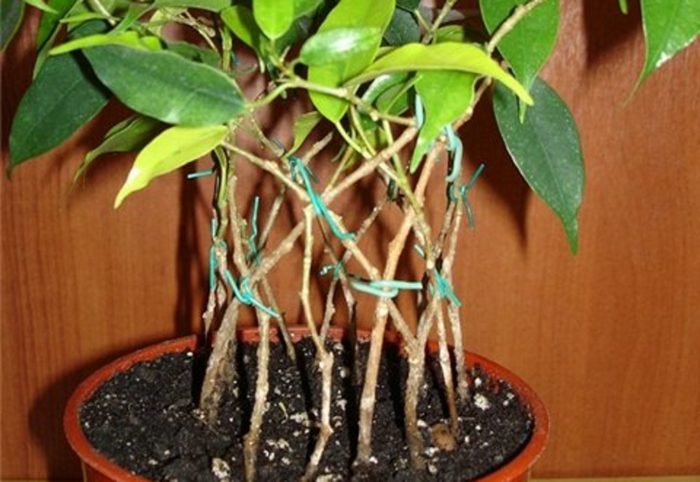

Growing at home
The best solution would be to place the ficus in diffused light. Since the plant tolerates light shading well, it can be placed at a temperature of 17-20 degrees. Lighting and temperature must be kept at the same level at all times.
More nuances about growing Benjamin ficus at home can be found here.
Crown formation methods
The formation of the crown of the Benjamin ficus is a creative process, but nevertheless, when it is carried out, it is necessary to follow certain rules that will relieve the plant of unnecessary stress.
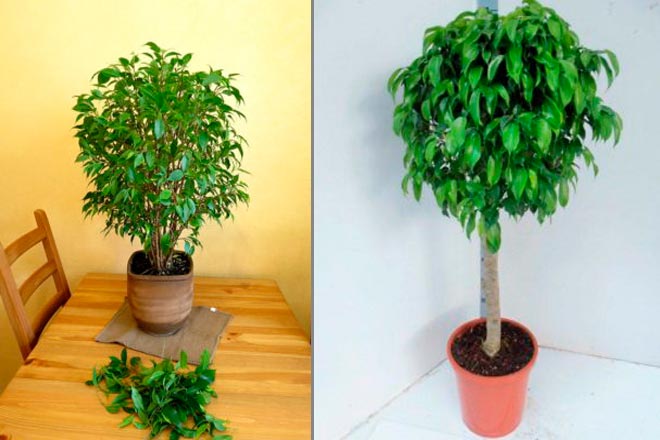

There are many ways to shape your ficus. The most common ones are:
- Pinching shoots. In order for the ficus to be fluffy, its upper buds are removed, and the branches are shortened. Recently cut shoots stop their growth for some time, but the lateral ones, on the contrary, accelerate it. The best time for this type of haircut is spring and summer.
- Topping. This procedure is quite delicate, so you need to do it very carefully, otherwise you can ruin the crown of the plant. Before pinching the branch, make sure the buds are below your chosen location. The direction in which they look depends on where the new shoot will grow. It is best to pinch ficus in early spring.
- Decorative grafting... If, due to improper lighting, the ficus began to grow in one direction, then the crown can only be corrected through this procedure. The end of spring - the beginning of summer, before the onset of extreme heat, is best for her.
- Crown reshaping with guides... This method is especially popular among gardeners who create bonsai from ficus. To direct the shoots in the right direction, you can use wire or ribbons (depending on the thickness of the branches). Thus, sculptural shrubs are created that do not require regular corrective pruning of the crown.
It is not difficult to form the crown of Benjamin's ficus. He is hardy, tolerates stress well, rarely gets sick after pruning. In addition, due to the specific properties of its roots, wounds heal quickly, and during the stage of active growth, new shoots are formed literally in 2-3 weeks.
Reproduction
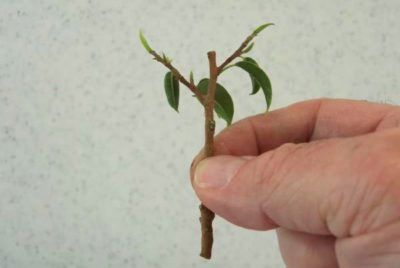

If there is not enough planting material, then the shoot can begin to develop from one bud. Cuttings are usually cut from an adult plant:
- The base of the seedling should be half wood, but flexible.
- There should be about 5 leaves on the stem.
On the cuts of the stems of all types of ficuses, milky juice can take place. Before rooting, it is removed with a napkin:
- Unripe cuttings do not take root.
- At the disposal of the grower there are only tree branches.
You can get acquainted with the secrets of reproduction of Benjamin's ficus in this article.
What is pruning for?
Benjamin ficus pruning is done for a variety of reasons. The most common ones are:
- Sanitary necessity. Most often, such a haircut is carried out after the shrub has suffered a disease, or for prevention.
- The method of forming the trunk. By cutting off the lower branches and leaves, you can strengthen the plant, make it taller. It is especially often used in the bonsai technique, for example, to create a trunk (a tree that has practically no branches).
- Anti-aging pruning. This method involves cutting not whole shoots, but individual leaves, and only old ones. Carried out for shrubs over 5 years old.
- Decorative. The most popular reason for clipping ficus. When carrying out it, the main thing is not to forget about the botanical features of a particular plant variety.
Pruning ficus for both aesthetic and practical purposes is not difficult if you follow the prescribed instructions, meet the deadlines and properly care for the plant after a procedure that brings stress to it.
Diseases and pests
Sometimes the plant can get sick - its leaves become covered with bubbles, which then begin to peel off.
Such a disease cannot be cured, and the plant must be destroyed.
Also on the leaves there may be bubbles that acquire a yellow-brown color.
The most common pests are:
- Mealy worm.
- Spider flare.
- Shield.
- Aphid.
You can read in more detail about the diseases and pests of Benjamin's ficus here.
Frequent formation errors
Failures in the formation of ficus are associated with improper care and pruning. Among them are the following:
- Too large and weak cuttings are planted.
- Irregular watering.
- Formation started too late when the trunk began to become woody.
- Support removed early.
- Pruning is done in winter when the crop is dormant.
Ficus is a noble plant that lends itself well to shaping and decorates the house for many years.


5 / 5 ( 1 vote)
Benefit and harm


Ficus Benjamin is a plant that does not pose a danger to humans. But those who have allergic reactions should be wary of it - ficus leaves secrete milky juice, which can affect well-being.
As for the benefits, it cannot be overemphasized. The plant purifies the air because it contains formaldehyde. This gas causes pain or nausea. It also absorbs harmful compounds like benzene and phenols. If ficus takes place in an apartment, it will create a pleasant atmosphere of relaxation in it.
You can read more about the properties of Benjamin's ficus in this material.
Ficus formation
Ficus Benjamin has the ability to quickly build up its leaf mass. Therefore, here you can deal with the formation of a plant and the goal of giving it an unusual look. To do this, pruning the crown and branches is carried out at home. As a result of this procedure, you can form a crown of any shape and size.
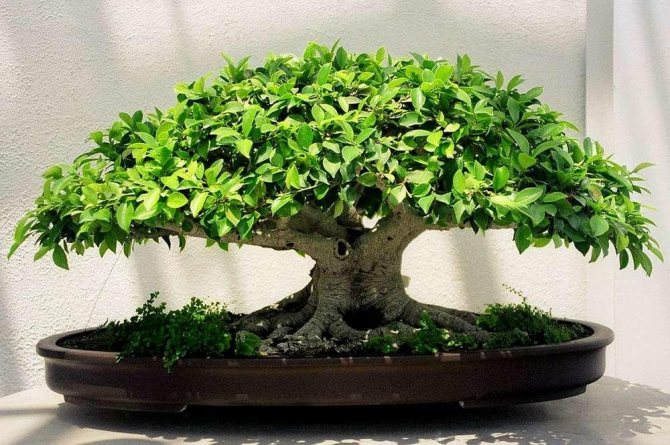

Please note that pruning and crown shaping for this plant is an integral part of the care, without which it is impossible to achieve a beautiful and decorative appearance of the bush. Moreover, to obtain the desired result, pruning at home can be carried out throughout the year. It is especially important to do this during the growth period. When caring for Benjamin's ficus, it should be remembered that pruning must be carried out correctly. During the dormant period of the plant, which lasts from October to February, it is better not to touch the bush, especially in terms of shortening it.
In order to correctly form the ficus of this variety, it must be remembered that its shoots grow from the buds. These kidneys are:
- apical. The splitting of such a bud during the dormant period will give an impetus to the development of lateral shoots. If this procedure is carried out during a period of active growth, then all lateral buds will go into growth;
- lateral.
The best time to prune is in spring, when it is actively growing and ideal results can be obtained. This time is also great for fertilizing the pot.
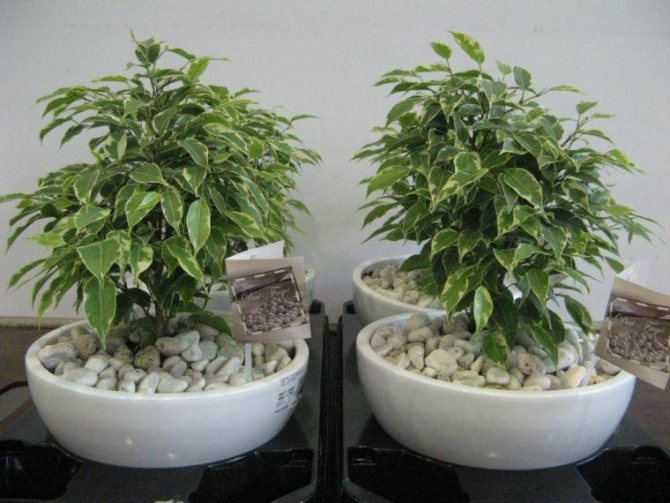

Separately, it should be noted that the formation of ficus at home affects the pruning of not only the crown, but also the root system. The roots can also be pruned, especially on older plants. Very often old bushes have roots that come out of the pot. The roots can even twist around the pot or become entangled with each other. This impairs their nutrition, so such roots should be pruned. In this situation, the roots must be cut off, as they spoil the appearance of the plant. But here it should be remembered that the roots must be cut in a mirror image in relation to the branches. Usually roots that are not species are not pruned.
Before giving an answer to the question "how to form the crown of the Benjamin ficus", you need to know what types of crowns for this plant generally exist. The crown of this ficus can be formed in different ways. At the same time, do not forget that the roots, if visible, are formed according to a similar pattern. Today, the Benjamin ficus crown can be designed as follows:
- stem. Often, such a crown is formed in young ficuses, in which the central shoot is well formed. In this situation, it is necessary to remove the lateral shoots from the 5 upper shoots. And after that, pinch the apical kidney. The result should be a bare pillar with a lush crown;
- bush. Such a crown is formed by pinching the main shoot. This leads to activation of lateral bud growth. When they reach a length of 10 cm, they should also be pinned. When forming a dense crown, it is necessary to remove those shoots that grow inside the crown;
- ficus weaving. To create such a crown, you need to plant several shoots in one pot. As they grow, a spiral or pigtails are woven from them. In addition, you can form more complex compositions, such as a wall or a fence. But if you are a novice florist, then it is better to start with simpler options: braids or spirals.
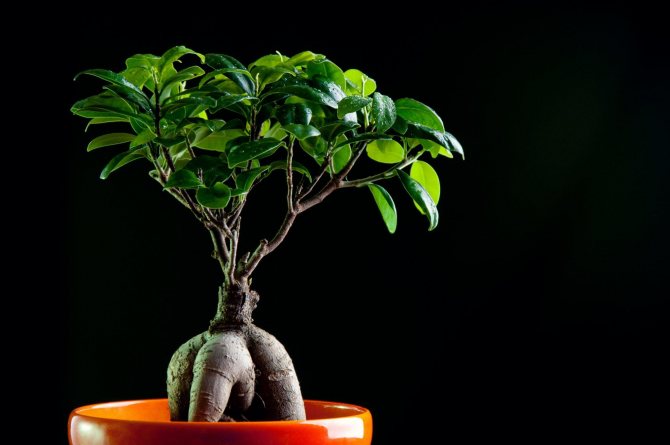

In addition, you can make crowns of the "tiered bole" type. To get such a crown, you should divide it into 3 parts. The first part is used to create the initial (first) level, and lateral processes are removed from subsequent levels.
Also, many people prefer to carry out the formation of a ficus of the "sculpture" type. This type of crown is used for all small-leaved varieties of ficus. This group also includes the ficus Benjamin. By pinching the buds and cutting off the shoots in different places, you can give the bush the shape of a bird, an animal, or a specific geometric figure. Here you need to calculate everything correctly to make the sculpture more realistic.
For beginners in this business, it is better to carry out the formation and pruning of shoots according to simple schemes, leaving more complex options, such as sculpture and fuco-weaving, to professionals.
The easiest way to form a ficus of this variety is to give it the shape of a ball. Here, at the age of two years, you should begin to pinch once a month, thereby provoking the growth of lateral branches. The most important thing here is to achieve a uniform and symmetrical crown. As you can see, the ficus Benjamin can be given the most diverse appearance. But this should be done only in the warm time of the day, as well as simultaneously with the introduction of fertilizers into the pot.
What is famous for the genus "ficus" from the mulberry family
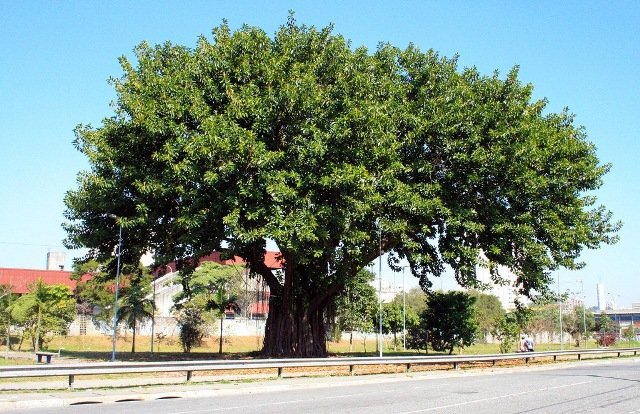

Ficus rubber in its natural environment
In enclosed spaces, rubber ficus is most common. Occupies an area limited by a tub or box and a space around no more than 1-2 meters in diameter. At home in the Indian jungle, the ficus genus is represented by a huge number of useful for aboriginal plants, from giant (under the shade of which more than 100 families can rest) to dwarfs in the form of miniature creeping shrubs. There are also strangler vines. Wrapping around trees, they grow into the master's trunks and strangle him "in love ecstasy."
For the first time, struck by the size of the ficus crown (in modern terms, about 300 m in circumference), this plant was described by the famous botanist Theophrastus more than 2000 years ago.
A closer acquaintance with the family surprises with its diversity and biological characteristics. In the amazing mulberry family, close relatives are:
- figs (fig tree, wine berry, fig, fig);
- mulberry (here, mulberry, king-berry);
- breadfruit (Jacques-tree with fruits weighing up to 20 kg);
- paper tree (the highest quality natural paper is made);
- cow tree (has the taste and nutritional value of milk);
- rubbery ficus (rubber tree, elastic or resilient ficus, contains 17.3% natural rubber);
- upas (anchar) is the most poisonous representative of the genus, perfectly described by A.S. Pushkin in the poem "Anchar".
Ficus in the room - botanical description


Ficus rubber is the most common type of potting culture for indoor floriculture.
Indoors, it is limited in growth by systematic pruning and usually has a height of 1.5-2.0 m. In natural nature, its height is more than 40 m.
A young single-stemmed tree, with high humidity indoors, forms aerial roots on the trunk and lateral branches with age. If you leave them, then reaching the ground, they form new trunks and the tree takes the form of a banyan tree - a multi-stemmed tree. The aborigines call the ficus "snake tree" for this feature.
It is considered the tree of well-being and family health. Floriculture enthusiasts attribute to ficus the ability to purify the air from pathogenic microbes by 40 percent or more.
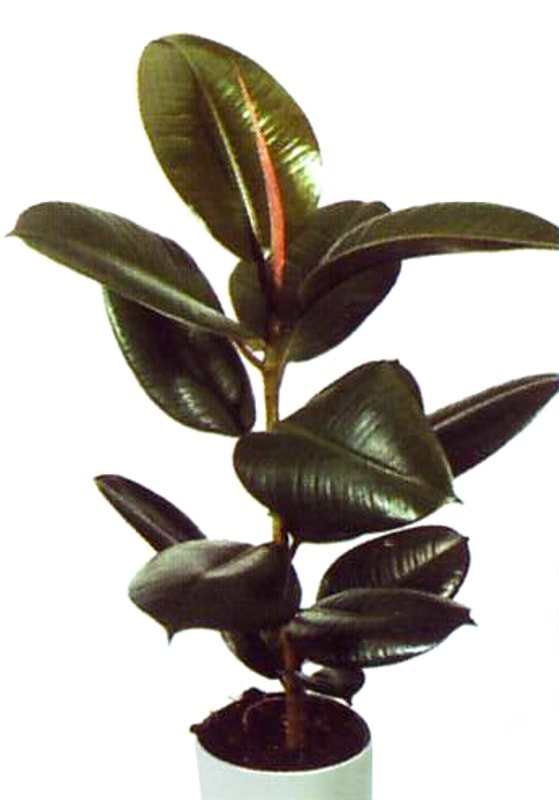

Young ficus leaves of a pinkish-brown color over time acquire the typical dark green of the culture. Petiole leaves, alternate arrangement. The leaf blade is oval elongated, leathery, with a shiny surface up to 30 cm in length and 10-20 cm in width.
In room culture, ficus practically does not bloom. When kept in greenhouses and conservatories, it can bloom at a very respectable age. After flowering, forms small oval syconia fruitlets up to 1 cm in diameter, yellow-green in color. In appearance, syconia resemble figs, but are inedible.
Sculpture - how to create a real masterpiece
In order to create a sculpture, it is important to know not only how to properly cut a ficus, but also how often it should be done. It must be said right away that creating a sculpture in the form of a bird, a flower or the like is a very difficult task that only a good sculptor or designer can handle. In this case, it is necessary both to perform a series of actions aimed at pruning unnecessary shoots, and to have imagination in order to create an exact copy of what was invented in advance. Benjamin's ficus will have little conventional knowledge of crown formation.
True, you can work hard to create a plant in the form of a cylinder, cone or snake. In this case, it is important to cut the flower in such a way that it acquires the desired shape. In one case, you will need to remove the upper shoots, in the other - the lateral or lower ones according to the principle, as described above. It should be said that pruning and shaping can take more than one year before the grower gets what he needs.
Very often, to give the trunk an unusual shape, gardeners come to tricks: they plant several cuttings, which are then weaved in the form of a pigtail; put a frame for the desired bend and more. If at the same time a special pruning of Benjamin's ficus is also used, then you can get an original decorative flower at the exit.
Be careful!
Ficus milky juice is poisonous to humans. Prune when there are no children or pets at home. Wear rubber gloves to protect yourself. Collect all cut pieces in a bag and throw them into the trash chute.
When you take a flower under the shower, you may accidentally break off a leaf or shoot. Make sure that the fragments are not scattered on the floor, where babies can find them and try to chew. Of course, a child will not be poisoned from one bite to death, but a burn of the mouth and a long roar will not bring joy to mom either.
It can be explained to older children that the plant is dangerous, so you cannot pick off the leaves on it. If babies live in the apartment, it is better not to put the tub on the floor, but to raise it on some kind of stand. However, keep in mind that the plant is heavy. The support must be reliable so that the bush does not topple over on people.
Bright flowers do not bloom on ficuses, but the green plant itself serves as a good interior decoration and a natural air filter. If you trim it correctly, a compact tree will appear in the house. With a good imagination, the bush can be given such a bizarre shape that it can compete with Japanese bonsai in decorativeness. Create original compositions that fit into any interior in style.
Ficus braiding
Ficus Benjamin is beautiful in any form. Not only plants with a crown are interesting. Trees grown by ficus braiding can be called a real work of art. Such plants have bare trunks intertwined with a special pattern. These ficuses are prized for their beautiful trunks. The crown of plants is usually shaped like a ball.
To obtain such a handsome man, all varieties of ficus with thin shoots are suitable. But the Viandi variety is categorically not suitable, since it has thick and curved trunks.
To obtain intricacies, several seedlings are planted in a pot (their number may be large), having the same size. Both plants must grow at the same time. The seedlings must be of the same variety, since then they will grow at the same rate. There are various patterns of ficus weaving. The simplest are the spiral and the pigtail.
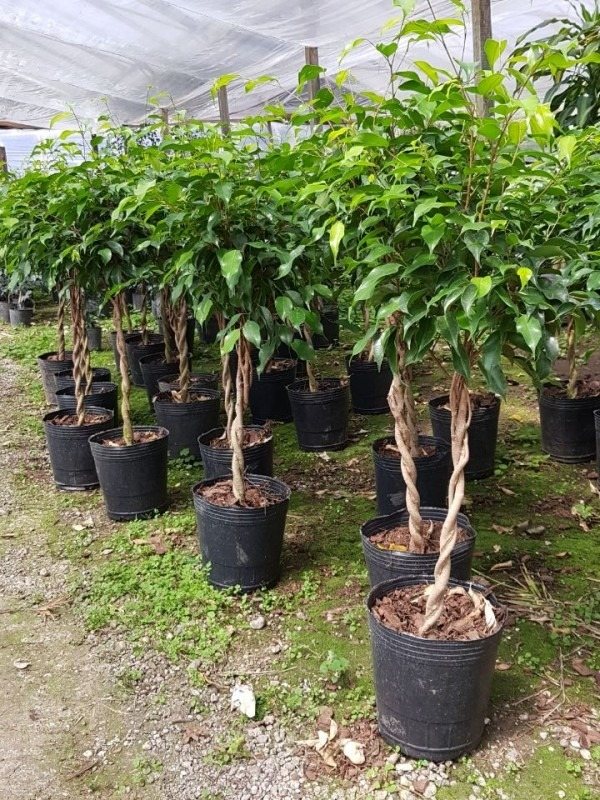

How to braid Benjamin's ficus to get a spiral? To do this, you need to plant two seedlings in a pot. But for the scythe you need three young plants. There are also more complex schemes. Sometimes, to bring them to life, you have to plant up to 20 seedlings. Such trees can only be grown by true professionals. To weave the trunks, it is necessary to remove the side shoots. All weaves should be fixed with copper wire or woolen thread. The shoots are fixed above the plexus site. In the future, the ficus is looked after in the usual way. As soon as the cuttings grow a little, another weave is made.
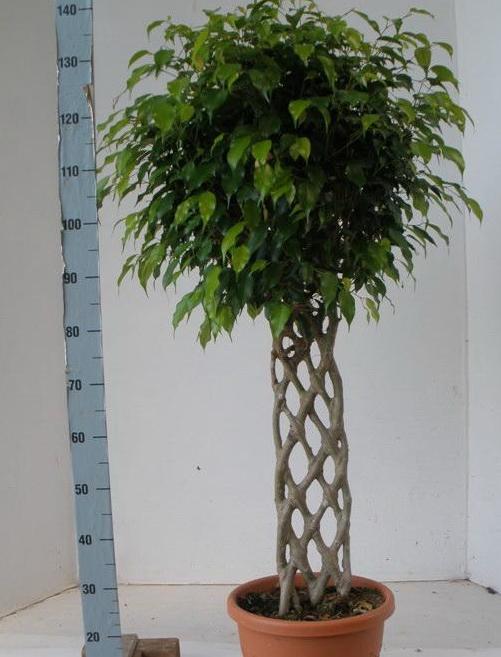

The attachment points should be checked every two months. Sometimes they need to be weakened, because during growth the trunks gradually thicken. If the fixation is too strong, it can injure the bark of the plant. As soon as the braid or spiral reaches the desired length, it is necessary to fasten the trunk from above. The attachment point will be securely hidden by the crown, so it will not be visible. After a few years, the stems will grow together and turn into a single whole. At this point, all fasteners can be removed. They are no longer needed.
general information
In order for Benjamin's ficus to form correctly, you need to know some features of growth. New branches grow from shoots, while shoots are formed from buds. The kidneys are of 2 types:
- Apical, located at the top of the trunk and responsible for the growth of the trunk upward;
- Lateral, responsible for the density of the crown and located along the trunk of the tree.
The upper kidney grows more intensively, its removal will lead to the rapid growth of the lateral ones. Removal of the upper sprout during the period of active growth will lead to powerful branching and growth of the lateral ones. Active growth occurs in spring, and in autumn and winter all plant processes slow down, so it is highly undesirable to carry out a cosmetic cut at this time.
Pruning in autumn or winter is fraught with the formation of a one-sided crown development, sometimes with a deformed (ugly) trunk.Modeling the crown of a tree, it is better to carry out at a young "age", interference with an already formed plant can lead to death or long-term recovery, see the conditions for proper care in this video.
Care after pruning
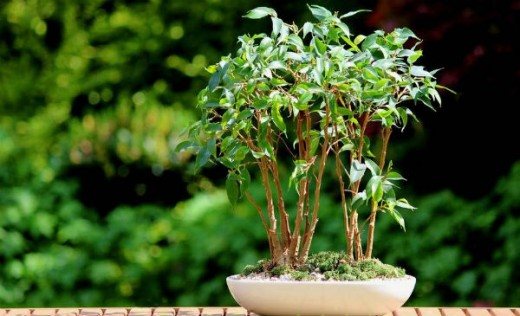

Let's get acquainted with the measures for caring for Benjamin's ficus after pruning.
Temperature and lighting
It is optimal to grow a flower at a temperature of + 13-22 degrees, but keep it away from heating batteries in winter. It is necessary to protect the plant from drafts, which the ficus is very afraid of. A flower can respond to temperature changes by dropping its foliage. A similar symptom speaks of an inappropriate place, and an urgent need to rearrange the ficus to another room - where there is no access to drafts.
Keep the plant out of direct sunlight, which can burn and stain the leaves. In winter, however, direct sun, on the contrary, will come in handy - but for several hours a day. Especially when it comes to Benjamin's variegated ficus.
Top dressing and watering
During the growing season, and especially after pruning, the ficus needs adequate nutrition. Use a special compound fertilizer for ficuses or a universal fertilizer.
Watering the flower is also necessary, but not too frequent. On average, the recommended frequency of moisturizing treatments is once a week. The soil should dry out between waterings. In the summer it is permissible to water more often, in the winter you can reduce the procedure to one in 10 days.
They are useful for spraying ficus: especially in dry air in winter in an apartment and in summer heat. Make sure that the flower is out of direct sunlight before spraying: otherwise, burns are possible.
In general, Benjamin's ficus tolerates pruning quite easily. And even, on the contrary, it usually activates and begins to grow better after it
So, we learned how to properly prune Benjamin's ficus, and what types of pruning exist. Now you know that to give a neat look to the plant, pruning is simply necessary: without these procedures, you cannot get a high-quality plant that decorates the interior. Fortunately, the pruning procedure is not that difficult - and even an inexperienced florist can do it if desired.
Stam
Stamp crowns are forms with a pronounced trunk. For growing a stem, a single cutting is planted. In the process of its growth, all the resulting lower lateral shoots are removed, leaving 3-4 upper ones.
If you want to grow a standard tree 50 cm high, then the length of the lower part of the trunk without branches should be 15-20 cm.
Usually desktop specimens are up to 50 cm high, and floor ones are much higher: 90-100 cm.
After the lower part of the trunk is formed, they begin to build up the crown. When the plant reaches the desired height, the upper shoot is cut 5-10 cm.
After that, side shoots begin to grow intensively. They need to be left only within the crown. If they form in the lower part of the plant on the trunk, then they must be removed.
Further, the crown is formed in the same way as a bush. When pruning, the outermost buds should be directed outward. Do not forget to treat the sections with activated charcoal.
The ficus stem crown can be given various shapes... The spherical crown is very popular and beautiful, but the oval shape, extended upward or to the sides, is no less decorative. When creating a crown in the shape of a ball, you need to leave shoots of the same length when pruning.
Difficulties in growing indoor ficus
The presence of a whitish bloom on the leaves of the ficus is a well-defined sign that the plant is watered too abundantly.
Sometimes growers can find on the back of the leaves black dots... From this we can conclude that the care of the plant was wrong. Soon you can see how the leaves begin to turn yellow, and the plant gradually withers.
Pests such as spider mites and scale insects, aphids and mealybugs can cause great harm to the plant. Laundry soap can be used to effectively kill aphids. You can get rid of other pests using insecticides.
What does a novice florist need to know?
Before you grab the scissors and cut half the branches of the tree, read some basic rules:
- You cannot cut off shoots at any time convenient for you. It is necessary to focus on the most favorable period for the growth and development of new stepchildren. The end of February - the beginning of March are most suitable for this purpose.
- Use only sharp sterile instruments for work. A utility knife, nail scissors, or a small pruner will work. The blade must be disinfected before use so as not to infect the plant with pathogens.
- If the cut stem is more than 2 mm thick, then sprinkle the cut site with activated carbon powder or garden varnish so as not to deplete Benjamin's ficus, the formation of the crown of which will require a lot of strength from him to restore.
- Places of cuts of small branches will tighten on their own. The milky juice that has come out must be wiped off.
- Shoots are cut almost at the base, trying not to leave hemp on the main trunk. They not only look unaesthetic, but also contribute to the multiplication of fungal spores. The small stems on the side branches are cut directly above the bud at right angles.
Bush
To form a bush, both undersized and tall ficuses are used. Small-leaved varieties are very popular: from them the bush turns out to be more lush. For the rapid formation of a bush crown, 2-3 cuttings are simultaneously planted in a pot close to each other.
After planting, as soon as a rooted stalk 15 cm high begins to grow, it is pinched from above, leaving at least 5 leaves. This stimulates the growth of 4-5 side shoots.
When the side shoots reach a length of 10-15 cm, their tops are also cut off.... In this case, the remaining upper buds should be directed not inside the crown, but outward.
All sections must be wiped with a napkin to remove the white juice, and sprinkled with activated charcoal.
After the second pruning, when the shoots of the third level reach a length of 10-15 cm, a rather dense bush is already obtained. With a strong density, you can cut 2-3 branches from the middle of the bush, thin it out.
When growing a bush crown, you need to evenly illuminate the plant or periodically turn it towards the light in different directions so that the shoots grow evenly.
Sanitary dead wood removal
During growth, weak or sore branches appear on the ficus. They dry out over time and give the appearance a sloppy appearance. In addition, they draw strength from the tree and are an ideal place for the development of pathogens. They are removed regardless of the season. The dry part is cut off with scissors, while the edge can not be processed with anything.
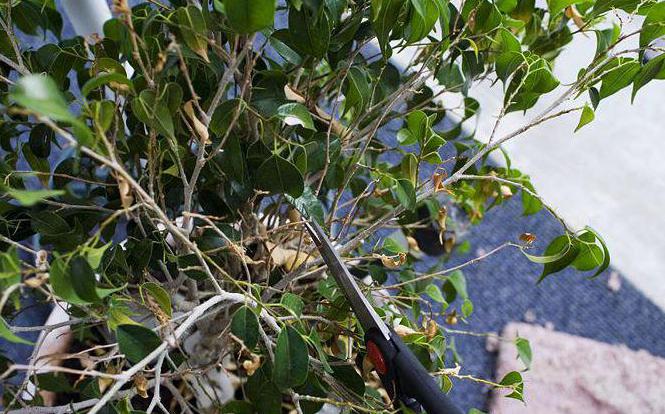

Preparing for pruning
Before pruning, you need to pre-prepare the ficus. Water it, remove dust from the leaves. Then prepare your inventory. You will need the following tools:
- garden pruner;
- small scissors (to trim thin small shoots).
Tools must be sharp and clean. It is also necessary to prepare a napkin, crushed activated or charcoal, an alcohol solution (or a solution of potassium permanganate). Disinfect the instruments, this will prevent pathogenic microflora from entering the sections. To do this, treat the blades with a solution of alcohol or potassium permanganate.
What problems can arise
During the crown formation procedure, the following problems may arise:
- An untreated pruning tool (knife) or untreated cuts can lead to infection.
- Do not make the crown too dense, as the branches will shade each other, and the leaves will begin to die off.
- It is not necessary to fix the ficus for the direction of growth immediately after transplanting, you need to wait 3 weeks to allow the plant to grow stronger.
- If a thin wire is used, a piece of fabric must be placed under it.
- It is better to use softer materials for molding. For example, tie the branches with a string or twine to a support.
- If the crown has not developed as you intended, then an adult plant is recommended to be vaccinated.
- With one-sided growth of shoots, you can resort to kerbovka - a special incision in the bark above the shoot you need to stimulate its growth.
- If the branch is growing in the wrong direction, then weights and guides can be used to give the desired direction.
By taking the time to properly prune and shape Benjamin's ficus, very interesting and decorative forms can be grown.
Useful properties and features of ficus
It is not difficult to grow ficus, you can even entrust the care of it to children. The plant does not bloom, but its leaves serve as real air filters and purify the air in the room. The pores draw in air polluted with smoke, harmful emissions from enterprises, and release a clean mixture of useful gases, enriched with oxygen. Instead of chemical fresheners, put a tub with an unpretentious plant in the apartment that requires minimal maintenance, and the atmosphere in the room will always be healthy and healthy for breathing.
There are not so many southern windows in the apartment, but you need to place both indoor flowers and seedlings on them. Almost all plants love the sun, but it is contraindicated for ficus, it must be placed in a shaded corner. But the green giant is very fond of swimming. If possible, from time to time wear a tub with a flower under the shower. If you cannot lift such a weight, wipe the leaves with a damp cloth. A dusty crown cannot be a good filter - if you want the flower to purify the air, provide it with proper care.
The peculiarity of the development of the ficus is that it has an apical bud, which gives an increase in height, and lateral ones, which give the crown a splendor. The first shoot grows very quickly, and the flower stretches upward. Lateral branches develop slowly, these buds can be dormant for a long time. In order for the tree to start up side branches, you need to correctly trim it.
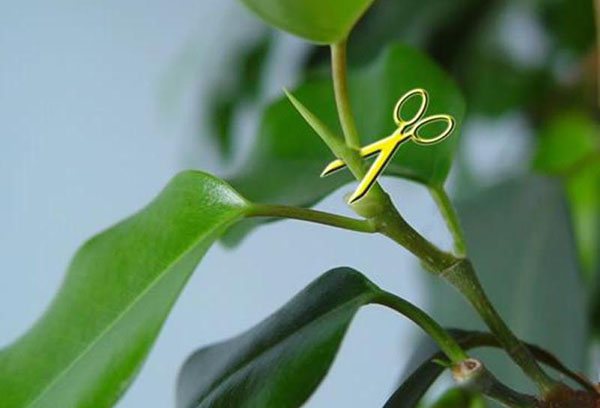

How to make a ficus stem
A stem is a tree with a bare trunk and a lush crown. To grow such an instance, do the following:
- buy or plant a single shoot in the center of the pot;
- as it grows, all lower branches are cut off with a sharp knife;
- a one-year-old plant should have five upper shoots;
- then the plant is grown to the desired height;
- when Benjamin's ficus (crown formation, pruning and pinching of which is carried out in the spring) grows to the desired height, they begin to trim it;
- it is better to tie a support to a thin stem, since a young specimen can bend over until it gets stronger;
- the lower side branches will have to be pruned constantly to get the desired result.
If you plan to grow a stem with several levels, then you need to form a central shoot. It will be the foundation that will allow you to grow a healthy tree.
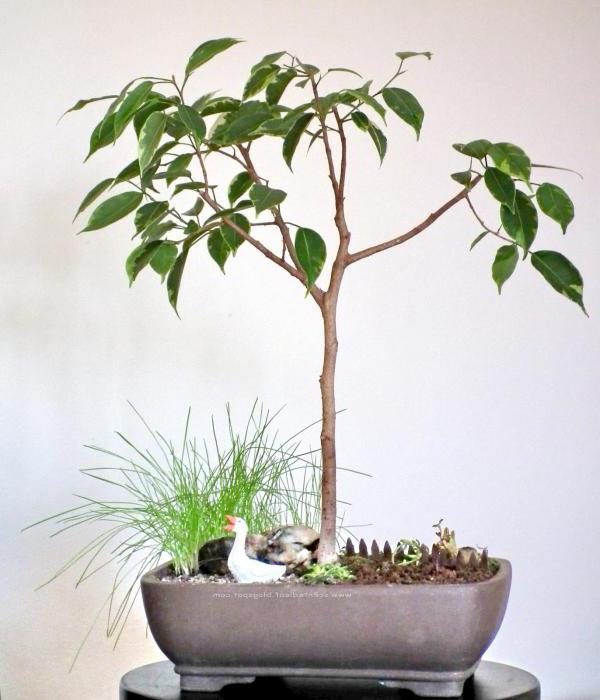

Longline bole - what is it
The tiered bole is a tree with not one, but two crowns, separated by a void of several centimeters. Such a tree, depending on its height, may even have more than two, and sometimes even three tiers.
Usually everything starts with one crown of Benjamin's ficus, and after that the tree is cut so that the central shoot grows, which will be directed upwards. Thanks to it, it will be possible to create an extension of the trunk, and, consequently, another tier. Gardeners note that this process is long and rather painstaking.
As for the longline stem, created from one cutting, it is formed as follows:
- First, one stalk is selected, growing upward and forming a tall stem.
- After the lower part of the trunk is formed (all shoots are removed), it will be necessary to divide the crown into three equal parts. The upper and lower parts will form the crown, and the middle will act as a bare trunk.
- After separation in the center, side shoots are removed. As for the top of the trunk, it is pinched. Everything else is done according to the same scenario as in the case of creating a conventional trunk.
Experienced flower growers recommend planting two cuttings in a pot at the same time, the trunks of which will need to be fastened with wire. Over time, at the bottom, the bases will grow together, and at the top they will be separated. Given the different sizes of plants, it will be possible to create trunks that will look like tiers.
Types of crowns and ease of formation
There are several types of crowns that can be created by pruning Benjamin's ficus:
- Shrub;
- Stamp;
- Longline bole;
- Sculpture.
Most varieties can also be used to grow miniature bonsai trees.
Although Benjamin's ficus is a tall tree, it is very easy to grow a bush from it. To do this, a central shoot is attached to a young plant. As a result, side branches begin to grow actively. Within a year, you can get a lush and beautiful plant.
Stamp forms are distinguished by a pronounced trunk and crown. Distinguish between a single and longline bole with a crown divided into several tiers, between which there is a trunk without shoots. Growing such a tree is a lengthy process that can take 3-4 years.
The sculpture is created from small-leaved varieties. The tree is given a pre-conceived shape. Pruning is done annually and very carefully, and the shape of the tree needs to be adjusted regularly.
Sculpture
It is very difficult to grow a crown in the form of a sculpture; work on it takes a long time. Only an experienced florist can create a tree in the shape of an animal or bird. It is easier to make a crown in the form of a geometric figure - a cone or a cylinder.
Even the formation of a simple geometric crown takes several years.
In this case, it is necessary to prune the plant annually in the spring, cutting off the branches in such a way that the crown takes on the desired shape.
Usually, branches are left pointing outward, and the crowns growing deeper are cut out.
At the same time, the outer part of the crown branches out strongly, so it becomes easier to give it the desired shape.
Bonsai creation
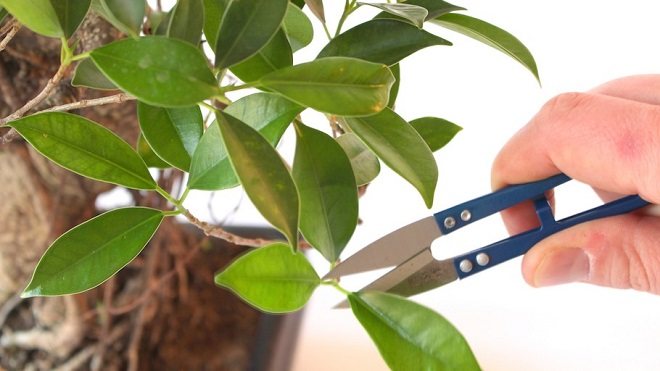

In order to form a bonsai, you do not need to know how to cut a ficus tree, because in this case its own separate technology is used.
Most often, Viandi ficus is taken to create the presented form, although you can take any other.
The whole process begins with the fact that the cuttings are grown in wide, but low flowerpots, which are filled with rather "poor" soil. This is necessary so that the ficus does not grow quickly. The roots are pruned several times a year.
As for the branches and the trunk, they are entwined with thick wire, so that afterwards they can bend it the way you want. This will create the desired shape for the plant. A beautiful mini-tree is obtained in 3-4 years.
When and how to trim
We will find out at what time to carry out the procedure and what tools and devices will be needed for it.
Time
Formative pruning of Benjamin's ficus should be carried out annually in early spring. The optimal time for this is late March or early April. The choice of this period is not accidental: after early spring pruning, the ficus, thanks to the active growth that has begun, will be able to recover and recover much faster.
Sanitary shortening is permissible at any time of the year when the need arises.
However, in the fall and winter, pruning the plant is still undesirable. The traumatic procedure during this period leads to a strong and rapid consumption of nutrients accumulated over the summer.
Instruments
Prepare the following accessories before the procedure:
- secateurs;
- charcoal - charcoal or activated;
- napkin;
- antiseptic - potassium permanganate or alcohol;
Disinfect the cutting tool so that no infection gets into the plant tissue. Put on long rubberized gloves and protect your face from splashes of milky juice - it is poisonous in ficus, it causes irritation if it gets on the skin.
Anti-aging pruning
Rejuvenating pruning allows you to restore the appearance of old plants or ficuses, the branches of which have dried up (for example, due to too long drying out of the soil). Do the manipulation in early spring. Cut off dead branches, shorten live ones by 1/2. Cut off all shoots, including the main ones. Treat the sections with crushed charcoal or activated carbon.
If the crown is completely dry, remove all branches, cut the trunk. The height of the "hemp" should not exceed 7-10 cm. Subsequently, Benjamin's ficus will grow shoots due to the developed root system. Provide the plant with optimal conditions. Please note that the ficus will not be able to recover if the roots are damaged.
Decorative varieties of rubber ficus for home cultivation
Common rubbery ficus forms a dark green leafy mass. Breeders have developed decorative varieties with variegated leaves. Among them, the most famous in home culture:
- Ficus elastica ‘Decora’, whose young leaves have an unusual bronze color;
- Ficus elastica ‘Doescheri’, the variegation is unusually elegant, literally mesmerizing;
- Ficus elastica ‘Robusta’ with fancy green leaves;
- Ficus elastica Black Princ, with almost black leaves;
- Ficus elastica variegata, variegated leaf blades with cream edges and other patterns;
- Ficus elastica trikolor with variegated leaves.
Features of pruning rubbery ficus
Pruning ficus rubber, in addition to technical issues, includes the correct use of simple tools. As a sharp object, both a sharp garden pruner and scissors can act. Scissors or pruning shears should be sharpened so that no ugly “creases” remain at the cut points. They are not only a cosmetic defect, but will also interfere with the full growth of shoots.
You should also take care of the disinfection of the instrument: most often, an alcohol solution or a solution of laundry soap is used. The pruner is treated with a disinfectant before pruning the plant and after cutting each branch - in order to avoid the ingress of dangerous fungal spores that may be in the air.
The milky juice secreted by any rubber plant causes unpleasant skin irritation, therefore, all work with ficus plants must be carried out with gloves, removing the juice from the trunk and other parts of the plant in time. It is also necessary to prepare in advance a powder of finely crushed activated carbon, with which it is necessary to process all the cut points. These rules should always be followed before forming the crown of the rubber ficus: they will help not to make mistakes when pruning.
Error correction
Sometimes, when forming the desired shape or type, the florist makes a number of mistakes or fails to achieve the desired shape, in such cases it is worth studying ways to correct the appearance of the ficus:
- In the case of one-sided growth, in order to increase the intensity of the growth of lateral buds, it is necessary to carry out the kerbovka procedure (a slight incision of the stiff bark above the sprout). Kerbination is carried out with a sharp and sterile object (blade, knife, scissors or scalpel). By making an incision over the shoot, thereby the florist stimulates growth in an already stiff area;
- Modeling the growth of branches with your own hands. With obvious imperfections of a house tree, you can set the directions for the growth of branches with your own hand, or tie it with ropes to the fasteners;
- Treatment with cytoxins (growth hormones) promotes artificial growth of ficus, as well as slowing down all aging processes in the trunk;
- With uneven development of the crown, they resort to vaccinations. Ficuses can be grafted with both individual shoots and whole branches of the desired shape. What is vaccination? This is a "plant surgery", that is, the transplantation (transplantation) of one part of the plant (from one species) to another. To carry out the vaccination, you need to cut off the desired part from one ficus and transplant to another using a scalpel (another sharp object) and a dressing tape (gauze or a piece of polyethylene). The necessary part is cut off from the donor plant and neatly attached to another (but which has already made the same incision). After the procedure, the transplant site is tied with tape.
How to properly prune Benjamin's ficus?
During the procedure, it is important to adhere to the following rules.
- Observe cleanliness. It is necessary not only to wash your hands before work, but also to carefully prepare the instrument. A small pruner or sharp scissors should be decontaminated. This can be done by wiping the sharp blade with alcohol. Another way is to bake the metal part of the tool over an open flame.
- Before pruning, carefully look at the flower. First, remove all dry twigs. Then you need to decide which parts to cut off in order to correct the shape of the plant. You can mark the border of removal with chalk or a bright ribbon, so as not to accidentally cut off a too large stem or the desired branch. This is important if the flower is very large.
- The cut is performed over the kidney. With a damp cloth, wipe the milky juice and sprinkle the wound with crushed charcoal. If you need to remove only a small upper section on a branch, pinch it.
- The resulting stems are not discarded. They can be used for plant propagation.
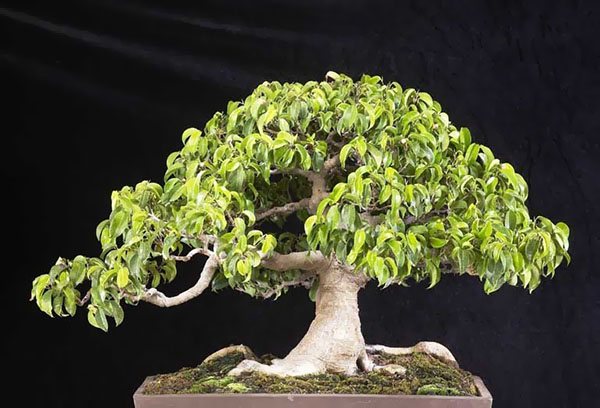

Sanitary pruning
As for sanitary pruning, it is carried out as needed. It is advisable to perform the procedure in early spring, but if dry, underdeveloped or diseased branches appear on the plant, then you should not wait for the right moment. Not everyone knows, but such shoots can become a cause that will entail the occurrence of various fungal infections. Some people are afraid to cut branches that are not needed, although there is nothing wrong with that. Such unnecessary shoots lead to the fact that the density of the crown increases, which does not allow light to pass inside.

